| s/y Nine of Cups Rediscovering America - Arizona Summer 2010 |
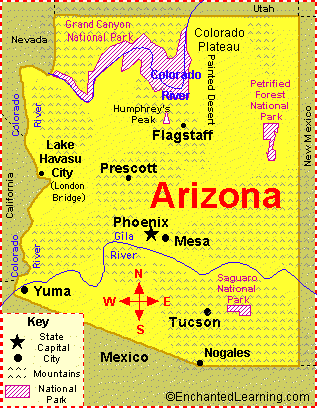
| Arizona Facts... Capital: Phoenix Area: 114,006 sq mi - 6th biggest state Population: ~ 6.6 million High Point: Humphreys Peak - 12,633' Low Point: Colorado River, only 70 ' State Nickname: Grand Canyon State State Flower: Saguaro cactus blossom State Bird: Cactus wren Arizona was the 48th state in the USA; it became a state on February 14, 1912. The word Arizona comes from one of the following (its origin is not certain): the Aztec Indian word "arizuma," that means "silver-bearing," from the Tohono O'odham Indian word "Aleh-zone" which means "small spring," or the Pima Indian word "Ali shonak" which also means "small spring." |
|

| We headed out of Gallup, NM and picked up Route 66 which parallels I40 west to Flagstaff. Do you remember Buzz and Marty? Of course, heading straight home would have been way too boring, so we found the Petrified Forest National Park not far off the track and decided to stop there for a visit. |
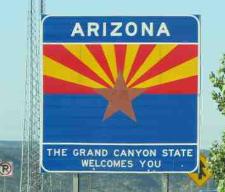
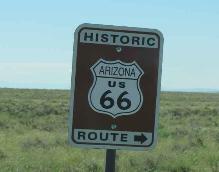

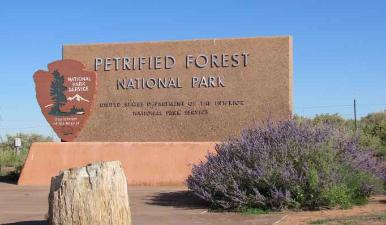
| Petrified Forest National Park was a unique place. A wonderful visitor center offered a free orientation film and lots of information about the area. A 28-mile park road crosses a painted desert, offers trails to the remains of a pueblo occupied some 600 years ago, Newspaper Rock and of course, lots of opportunity to see petrified wood. |
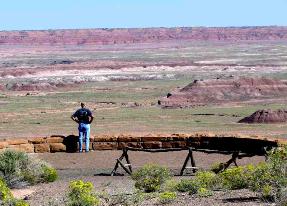

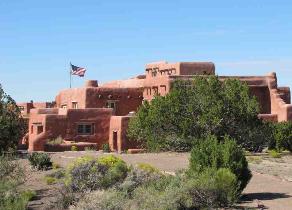
| David surveys the beauty of the painted desert. |
| The Painted Desert Inn is now a national historic landmark which is part of the national park. |
| The Blue Mesa trail meandered through a different type of landscape. |
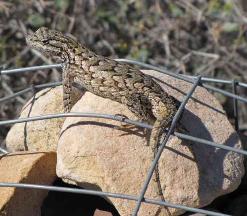
| A side-blotched lizard suns himself. |

| The remains of the Puerco Pueblo which was inhabited about 600 years ago. |
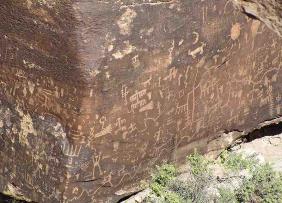
| Newspaper Rock was very intriguing with more than 650 petroglyphs etched on it by native peoples of the past. |
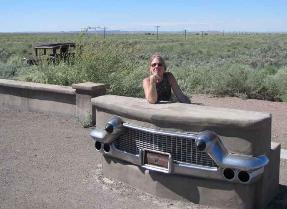
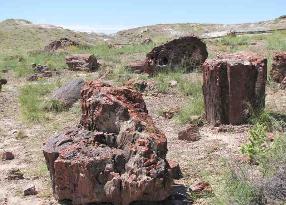
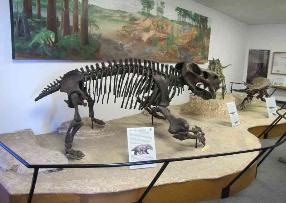
| At the point where the park road crossed over Rte 66, there was a monument to the Mother Road. |
| The Rainbow Forest Museum, also part of the park, offered a "petrified forest trail", lots of petrified wood exhibits and displays of prehistoric animals that roamed the area in the Triasic period. Above, a model therapsid. |
| Prehistoric trees in this ancient floodplain, fell and were washed downstream, got waterlogged and sank. Silt, mud and volcanic ash buried the logs and silica-laden groundwater seeped through the logs, replacing wood tissue with silica deposits and voila...petrified wood! The petrified log "boulders" were innumerable in spite of the fact that many visitors take illegal souvenirs. |
| Okay, so we really should be making tracks, BUT there was the sign for Walnut Canyon National Monument and cliff dwellings...what could we do? We had to stop. We're addicted to national parks! |

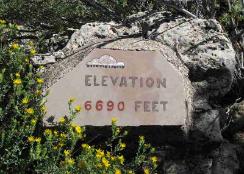
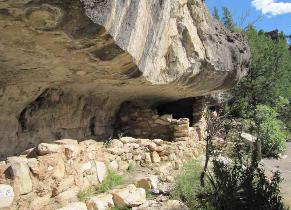
| Our ears were popping! |
| The native peoples who lived here under the overhanging limestone cliffs are known today as Sinagua (people without water). |
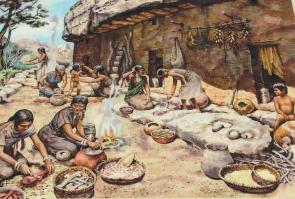
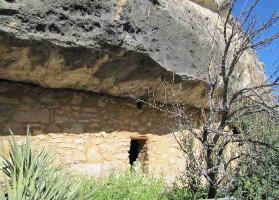
| A self-guided, well-illustrated Rim Trail allowed us to use our imaginations to conjure of up images of what life must have like. |
| The dwellings have been dated to between 1125-1250 AD and the people were very innovative in their use of their natural resources. |
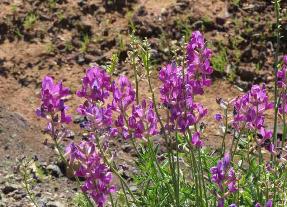
| Marcie noticed some fuchsia flowers en route to the park and asked the ranger what they were...locoweed! |
| Trading posts were and are common in New Mexico and Arizona. They sell, buy, trade, barter and pawn. |
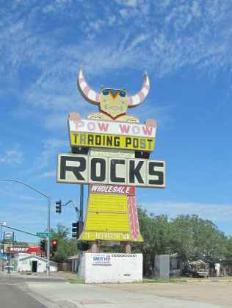

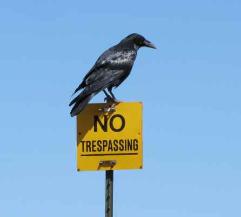
| We got a charge out of the "Welcome to Holbrook, AZ" sign which incorporated the local petrified wood into the act. |
| Quoth the raven: "No trespassing!" |
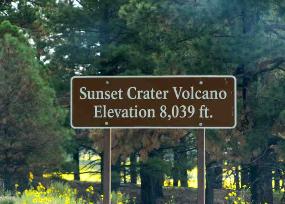
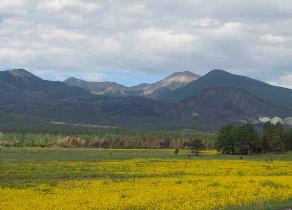
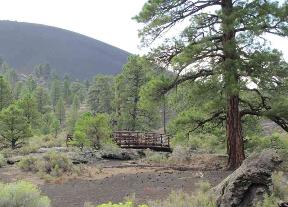
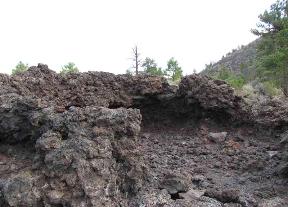
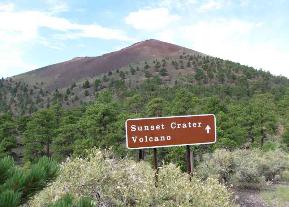
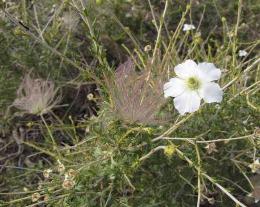
| We spent the night in Flagstaff and found there were two other national monuments in the area. The road to Sunset Crater Volcano was a blanket of sunflowers. |
| The volcano "blew its top" sometime between 1040 and 1100 and is the most recent volcanic activity in the Flagstaff area. |
| A one-mile Lava Loop Trail at the volcano's base allowed us to view a variety of features illustrated by well-placed placards. |
| A spatter cone is formed of molten lava ejected from a vent with the consistency of taffy. Expanding gases in the lava fountains tear the liquid rock into irregular gobs that fall back to earth, forming a heap around the vent. The still partly liquid rock splashes down and over the sides of the developing mound is called spatter. |
900 years after the eruption, vegetation is still
limited and the sides and edge of the crater
are still ash, cinder and barren.
limited and the sides and edge of the crater
are still ash, cinder and barren.
| One of the most prevalent flowers in the area is Apache plume. |
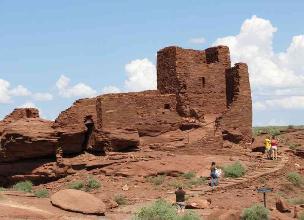
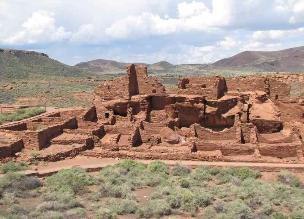
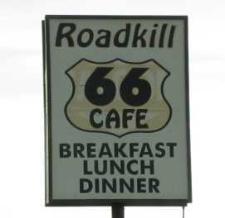
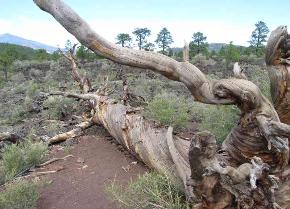
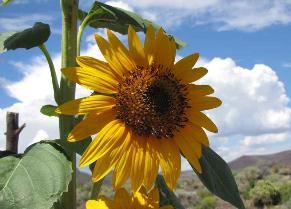
| Airzona's natural wonders include the Grand Canyon, Havasu Canyon, Grand Canyon Caves, Lake Powell/ Rainbow Bridge, Petrified Forest/Painted Desert, Monument Valley, Sunset Crater, Meteor Crater, Sedona Oak Creek Canyon, Salt River Canyon, Superstition Mountains, Picacho Peak State Park, Saguaro National Park and Chiricahua National Monument. |
| The original London Bridge was shipped stone-by-stone and reconstructed in Lake Havasu City. |
| Ponderosa pine grows in spirals as seen by the trunk above. |
| There were some sunflower whoppers in a "native" garden near the visitor center. |
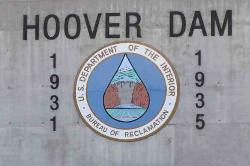
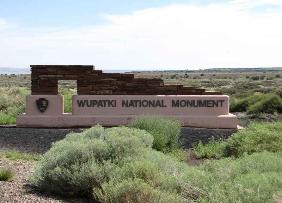
| Wupatki National Monument is just north of Sunset Crater Volcano, but is a totally different experience. |
| The sunflower plant is native to North America. The wild sunflower is so common in the plains states, it is actually a serious weed problem. |
| The Wukoki Pueblo ruins were beautiful, but this was just a warm-up for the Watpaki Pueblo ruins just up the road. |
| These ruins were absolutely magnificent. At least 125 different types of pottery have been found here suggesting that a rich culture lived and traded here during the 1100's. |
| All too soon we were back on the road, driving the last leg to Las Vegas. Couldn't resist a quick stop at the"Road Kill Cafe". |
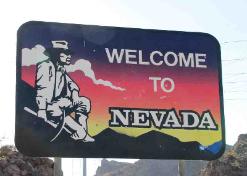
| We crossed over the Hoover Dam and knew we were nearing our final destination. |
| After nearly 2 months on the road, we returned to Nevada where we'd stay for a couple of weeks before returning to New Zealand and "Nine of Cups". David has lots of house projects to complete for his sister and Mom. Marcie has all that "thrifting" to do to complete her wardrobe for the next year or two. So the end of yet another adventure...stay tuned for more updates when we get back to New Zealand. Who knows where you'll find us next? |
| The last "Welcome to" on our trip! |